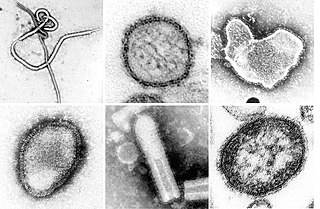
Orthohantavirus is a genus of single-stranded, enveloped, negative-sense RNA viruses in the family Hantaviridae within the order Bunyavirales. Members of this genus may be called orthohantaviruses or simply hantaviruses.

Bunyavirales is an order of segmented negative-strand RNA viruses with mainly tripartite genomes. Member viruses infect arthropods, plants, protozoans, and vertebrates. It is the only order in the class Ellioviricetes. The name Bunyavirales derives from Bunyamwera, where the original type species Bunyamwera orthobunyavirus was first discovered. Ellioviricetes is named in honor of late virologist Richard M. Elliott for his early work on bunyaviruses.

Viral hemorrhagic fevers (VHFs) are a diverse group of animal and human illnesses in which fever and hemorrhage are caused by a viral infection. VHFs may be caused by five distinct families of RNA viruses: the families Filoviridae, Flaviviridae, Rhabdoviridae, and several member families of the Bunyavirales order such as Arenaviridae, and Hantaviridae. All types of VHF are characterized by fever and bleeding disorders and all can progress to high fever, shock and death in many cases. Some of the VHF agents cause relatively mild illnesses, such as the Scandinavian nephropathia epidemica, while others, such as Ebola virus, can cause severe, life-threatening disease.

Orthobunyavirus is a genus of the Peribunyaviridae family in the order Bunyavirales. There are currently ~170 viruses recognised in this genus. These have been assembled into 103 species and 20 serogroups.
Bunyamwera orthobunyavirus (BUNV) is a negative-sense, single-stranded enveloped RNA virus. It is assigned to the Orthobunyavirus genus, in the Bunyavirales order.

Nudiviruses are a family of animal viruses that constitute the family Nudiviridae. Insects and marine crustaceans serve as natural hosts. There are 11 species in this family, assigned to 4 genera. Diseases associated with this family include: death in larvae, chronic disease in adults.

The Herpesvirales is an order of dsDNA viruses with animal hosts, characterised by a common morphology consisting of an icosahedral capsid enclosed in a glycoprotein-containing lipid envelope. Common infections in humans caused by members of this order include cold sores, genital herpes, chickenpox, shingles, and glandular fever. Herpesvirales is the sole order in the class Herviviricetes, which is the sole class in the phylum Peploviricota.

Severe fever with thrombocytopenia syndrome (SFTS) is a tick-borne infection. Signs and symptoms include fever, vomiting, diarrhea, loss of consciousness and heamorrhage.
Dabie bandavirus, also called SFTS virus, is a tick-borne virus in the genus Bandavirus in the family Phenuiviridae, order Bunyavirales. The clinical condition it caused is known as severe fever with thrombocytopenia syndrome (SFTS). SFTS is an emerging infectious disease that was first described in northeast and central China 2009 and now has also been discovered in Japan, South Korea, Vietnam and Taiwan in 2015. SFTS has a fatality rate of 12% and as high as over 30% in some areas. The major clinical symptoms of SFTS are fever, vomiting, diarrhea, multiple organ failure, thrombocytopenia, leukopenia and elevated liver enzyme levels. Another outbreak occurred in East China in the early half of 2020.
Heartland bandavirus, sometimes called Heartland virus (HRTV), is a tick-borne phlebovirus of the Bhanja virus serocomplex discovered in 2009. The lone star tick transmits the virus to people when feeding on blood. As of 2017, only five states in the Central United States have reported 20 human infections, namely Arkansas, Indiana, Missouri, Oklahoma, and Tennessee; symptoms resemble those of two other tick-borne infections ehrlichiosis and anaplasmosis. The reservoir host is unknown, but deer, raccoon, coyotes, and moose in 13 different states have antibody titers against the virus.
Naples phlebovirus is an antigenic species of genus Phlebovirus within the family Phenuiviridae of the order Bunyavirales. It is an enveloped RNA virus with a tripartite genome e Uukuniemi (UUK) serogroup. The Sandfly group's natural reservoir are sandflies, while the natural reservoir for Uukuniemi is ticks. The SFNV serogroup consists of two main serocomplexes associated with disease in humans, the Naples and Sicilian serocomplexes. Sandfly fever induces myalgia, fever, and elevated liver enzymes in humans. It is difficult to diagnose outside endemic areas.
Tahyna orthobunyavirus ("TAHV") is a viral pathogen of humans classified in the California encephalitis virus (CEV) serogroup of the Orthobunyavirus family in the order Bunyavirales, which is endemic to Europe, Asia, Africa and possibly China.
Batai orthobunyavirus (BATV) is a RNA virus belonging to order Bunyavirales, genus Orthobunyavirus.
Phasmaviridae is a family of viruses with negative stranded RNA genomes associated with insect hosts. They are a member of the order Bunyavirales. Phasmaviruses were first discovered in phantom midges of the genus Chaoborus in 2014.

Negative-strand RNA viruses are a group of related viruses that have negative-sense, single-stranded genomes made of ribonucleic acid. They have genomes that act as complementary strands from which messenger RNA (mRNA) is synthesized by the viral enzyme RNA-dependent RNA polymerase (RdRp). During replication of the viral genome, RdRp synthesizes a positive-sense antigenome that it uses as a template to create genomic negative-sense RNA. Negative-strand RNA viruses also share a number of other characteristics: most contain a viral envelope that surrounds the capsid, which encases the viral genome, −ssRNA virus genomes are usually linear, and it is common for their genome to be segmented.
Nucleocytoviricota is a phylum of viruses. Members of the phylum are also known as the nucleocytoplasmic large DNA viruses (NCLDV), which serves as the basis of the name of the phylum with the suffix -viricota for virus phylum. These viruses are referred to as nucleocytoplasmic because they are often able to replicate in both the host's cell nucleus and cytoplasm.

Adnaviria is a realm of viruses that includes archaeal viruses that have a filamentous virion and a linear, double-stranded DNA genome. The genome exists in A-form (A-DNA) and encodes a dimeric major capsid protein (MCP) that contains the SIRV2 fold, a type of alpha-helix bundle containing four helices. The virion consists of the genome encased in capsid proteins to form a helical nucleoprotein complex. For some viruses, this helix is surrounded by a lipid membrane called an envelope. Some contain an additional protein layer between the nucleoprotein helix and the envelope. Complete virions are long and thin and may be flexible or a stiff like a rod.

Rose rosette emaravirus (RRV) is a negative sense RNA virus species of virus in the order Bunyavirales. It is known to infect roses, in which it causes witch's broom and sometimes excessive growth of prickles. The virus is transmitted by a microscopic Eriophyid mite Phyllocoptes fructiphilus. The disease takes 3-4 years to properly phenotype and thus is a hard disease to breed resistance to the virus. Breeding work began with cultivar resistance trials and then morphed into bi-parental and interconnected populations for mapping disease resistance. Recently there have been the first two studies identifying loci for resistance on both the diploid and tetraploid level using mapping populations developed at Texas A&M University Rose Breeding and Genetics Program. On the diploid level, QTL were found on linkage groups (LGs) 1, 3, 5, and 6 and on the tetraploid level, QTL were found on LGs 5, 6, and 7.
Bunyaviridae nonstructural S proteins (NSs) are synthesized by viral DNA/RNA and do not play a role in the replication or the viral protein coating. The nonstructural S segment (NSs) created by Bunyaviridae virus family, are able to interact with the human immune system, in order to increase their replication in infected cells. Understanding this mechanism can have global health impacts.
Leishbunyaviridae is a family of negative-strand RNA viruses belonging to the Bunyavirales order, which infect protozoans. It only contains one recognized genus Shilevirus. But another genus Leishbunyavirus has also been proposed.









